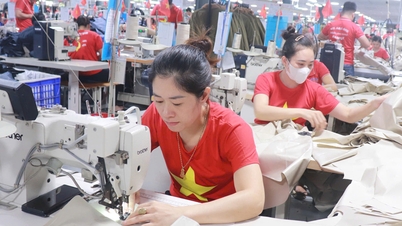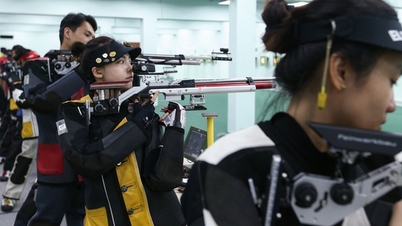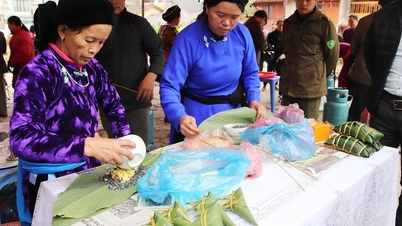Consequences
Mr. Nguyen Van Hieu, Van Ha ward, is very excited to have a grandson before he turns 50. According to Mr. Hieu, his son is a worker in a foreign enterprise, often traveling to many places for work, and his children have decided to have only 2 children, so he feels secure that his first grandchild is a boy.
 |
Class time of teachers and students at Tan Hung Kindergarten (Lang Giang commune). |
Ms. Nguyen Thi Ngoan, Vo Cuong ward, gave birth to a son in the year of Nham Thin 2012, everyone congratulated her because of the concept that "boys born in the year of the Dragon will be lucky, have a good future". Now, looking back, Ms. Ngoan can't help but worry: "That year, the number of children born was very large. I see that in many classes with students born in 2012, the majority of boys are boys. Later on, my child will have to compete fiercely in exams, find a job and may have difficulty finding a partner".
Not only is it a story of each family, gender imbalance at birth has become an alarming reality. Tu Son City (before the administrative unit arrangement) is a typical example. From 2021 to now, the sex ratio at birth has always been maintained around 130 boys/100 girls, especially in 2024 it reached 135.5/100.
Ms. Nguyen Thi Hien, Head of the Department of Population - Communication and Health Education, Tu Son Medical Center, explained that the local economy is developing rapidly, the living standards of the people are getting higher and higher, so many families have the conditions to choose the gender of the fetus. "Many families who do not have a son want to have "both boys and girls", some families who already have a son want to have another boy" - Ms. Hien commented.
In Bac Giang province (before the administrative unit arrangement), in the past 10 years, the sex ratio at birth fluctuated around 114-116 boys/100 girls. Notably, this ratio changed significantly according to birth order. In the period 2017-2019, if the first birth was 103-107 boys/100 girls, the second birth increased to 110.5 boys, the third birth was 148.8 boys and the fourth birth and up to 186 boys/100 girls. This clearly reflects the mentality of trying to have a son that still exists in many families.
Bac Ninh (old) is a region with a high birth rate (total birth rate of more than 2.5 children/woman) and the sex ratio at birth is always very high, with more than 120 boys/100 girls. In 2016, only 2/8 districts, towns and cities in the province had a sex ratio at birth of more than 120 boys/100 girls, but by 2021, the number of localities had increased to 6/8 and by 2024, it was 7/8 units, of which 3 localities had a ratio of more than 130 boys/100 girls.
A 2022 study by a team of experts from the Australia-World Bank Strategic Partnership Program presented two scenarios worth pondering. The first scenario, if the sex ratio at birth gradually returns to its natural balance by 2039 and stabilizes in the following years, by 2044, Vietnam will still have about 1.3 million men aged 20-39 in "surplus" and by 2049, it will increase to 1.7 million. The second scenario, if the sex ratio at birth remains at 111/100, by 2054, there will be about 2 million men aged 20-49 who cannot find a partner. The consequence is that millions of men will marry late or not be able to marry, increasing the risk of social instability, leading to many other consequences.
Need fundamental solutions
Speaking to reporters of Bac Ninh Newspaper, Professor - Doctor Nguyen Dinh Cu, former Director of the Institute of Population and Social Issues (National Economics University) analyzed four groups of factors that strongly affect the sex ratio at birth, including: Traditional norms and values, family; changes in the economy - society; policies; access to technology. "Millions of Vietnamese men will not be able to marry, living single for life. The economic, mental, health, social security consequences... will certainly be very serious. This issue directly or indirectly affects the quality of life of each person, each family and the whole society" - Professor - Doctor Nguyen Dinh Cu warned.
 |
Health check-up for students at Vo Thi Sau Primary School, Bac Giang Ward. Photo: Minh Thai. |
The fundamental solution to the gender imbalance at birth cannot be limited to administrative sanctions or recommendations. Because the deep roots of the problem lie in gender stereotypes, the belief that only sons can continue the family line and take care of their parents in their old age. It is this mentality that makes many people, despite understanding the long-term consequences, still try to choose the sex of their fetus.
Addressing the issue of gender imbalance at birth and gender discrimination in the family requires a comprehensive system of solutions. In which, behavioral change communication plays a key role. Men need to become active forces in promoting gender equality. Policies need to ensure women have full access to free legal services to exercise their inheritance and property rights, contributing to eliminating the prejudice that women and girls are not respected in the family. Society needs to properly recognize the great contributions of women and girls in both the formal and informal economic sectors.
Strengthening the social protection system for the elderly will also help reduce the mentality of trying to have a son so that someone will take care of them in their old age. At the same time, it is necessary to tighten the abuse of technology to determine and select the sex of the fetus, but still ensure the right to voluntarily access safe abortion services for women. Community models to reduce gender imbalance at birth need to be replicated in residential areas to create positive social effects and spread correct awareness.
Source: https://baobacninhtv.vn/kiem-soat-mat-can-bang-gioi-tinh-khi-sinh-thay-doi-nhan-thuc-hanh-dong-kip-thoi-postid421676.bbg








![[Photo] National Assembly Chairman Tran Thanh Man chairs the second meeting of the National Election Council](https://vphoto.vietnam.vn/thumb/1200x675/vietnam/resource/IMAGE/2025/9/15/e36ad05720d645bcba04598f17349e32)




































































































Comment (0)